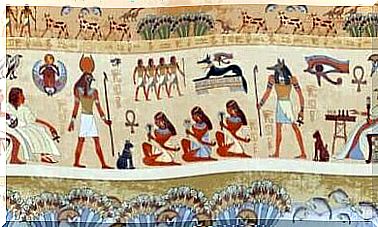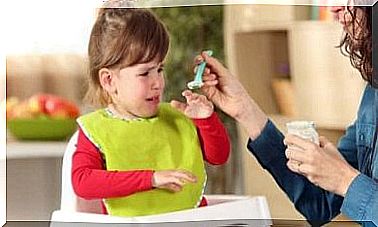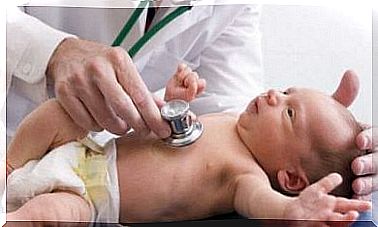What Are The Components Of Breast Milk?

Breast milk is unique and cannot be imitated. The composition changes according to the age of the baby, its needs, as well as the time of year. Do you know what the components of breast milk are?
Nature is very smart. Breast milk has exactly the ingredients that your baby needs for its development.
According to the World Health Organization, children receive good nutrition from breast milk up to the age of 3, provided other foods are added.
In addition, breastfeeding also helps create the bond between mother and child – a loving relationship and a channel of dialogue between the two. A wonderful side effect.
Breastfeeding offers the emotional security for the beginning of life that every person needs
-Anonymous-

How is breast milk produced?
First, the mother produces colostrum, a watery, yellowish substance, rich in minerals and vitamins A, E, K and B12. It is very easy to digest and has a laxative effect. It therefore helps to expel the stool accumulated during pregnancy from the intestines of the child.
This colostrum is composed of leukocytes and antibodies. These substances are responsible for protecting the baby from possible intestinal and respiratory infections until his immune system develops.
A few days after delivery there is an increase in milk itself, a substance with a low protein content but on the other hand a high content of fats and carbohydrates.
In the beginning it is very thin and later it becomes creamy. It is this change in texture that allows the newborn to quench its thirst first, and then its appetite.
We will now discuss what the components of breast milk are.
What are the components of breast milk?
Water
One of the components of breast milk is water. Water is the most abundant component of breast milk. Among other things, it contributes to the newborn’s ability to regulate its body temperature.
It has been shown that the needs of infants can be fully satisfied by the water in breast milk.
Protein
Protein is one of the other important components of breast milk. Many of the properties of breast milk can be traced back to these unique proteins.
A characteristic of breast milk is that there is a predominance of serum proteins over casein. From a nutritional point of view, casein does not just function as a protein. Fragments of it are also part of the bifidus factor and others have functions related to defense.
Lactoferrin is another important serum protein. It helps to protect the newborn from microorganisms. This protein binds to iron and prevents bacteria from multiplying.
Immunoglobulins or antibodies are proteins that are able to bind to structures and recognize what they are directed against. Recognition of the antigen (a virus or bacteria) causes the immune system to destroy it. They are therefore very important due to their protective effect.
When an immunologically mature child drinks breast milk, he receives antibodies against microorganisms to which he is exposed.
Carbohydrates

The main carbohydrate in milk is lactose, which is formed in the mammary gland.
Its main function is to provide energy. But for the newborn, it seems to be particularly important for growth, as it has the following beneficial properties:
- It facilitates the absorption of calcium.
- It is a source of galactose, which is essential for the production of galactolipids. These substances are essential for the development of the central nervous system.
- It influences the volume control of the milk and also regulates the transport of water.
- It is part of the bifidus factor.
The lactose content is quite constant in every mother’s milk throughout the day. Even in mothers with poorer nutrition, lactose levels do not vary.
oils
Fats and oils are an important source of energy and are essential for the development of the nervous system. They are therefore important components of breast milk.
Fat is the most variable component of milk. The fat content increases during the day and during the diet, with low values at the beginning and high levels at the end.
During drinking, fat globules increasingly replace the watery phase of the milk.
Breast milk provides fatty acids related to vision. For example, it was shown that children who receive artificial milk have less sharp vision than those who receive breast milk.
Mineral salts
A breastfed child can handle body fluids more easily, for example to control the temperature by sweating.
- Sodium and potassium: Potassium levels are much higher than sodium, which is comparable to the amount found in cells. A low sodium level and a high potassium level in breast milk have a beneficial effect.
- Iron: The rate of iron absorption from breast milk reaches 50% of the available iron. Children who have been exclusively breastfed for the first 6 months are much less likely to develop an iron deficiency, known as anemia.
- Calcium: The calcium and phosphorus content is low in breast milk but, on the other hand, it is easily absorbed.
- Zinc: Breast milk contains bioavailable zinc. Acrodermatitis enteropathica, an inborn alteration of zinc metabolism, does not occur in breastfed infants.
Vitamins


The water-soluble vitamins are taken in amounts suitable for the child.
- Vitamin A: Vitamin A, like all fat-soluble vitamins (A, E, D and K) are transported in milk fat. Its content is even higher in colostrum and in the milk of mothers of premature babies.
- Vitamin D: The main source of vitamin D is sun exposure, not through food. There are no deficiencies in children who are exclusively breastfed.
- Vitamin E: Breast milk provides more than enough vitamin E while colostrum even has about 3 times more vitamin E than later milk. This is important because babies have low reserves and need an adequate amount in their first days of life.
- Vitamin K: The concentration of vitamin K is higher in colostrum and in transitional milk.
Finally, a few quirks…
- Breast milk is a watery substance of nutrients, cells, hormones, growth factors and immunoglobulins (antibodies) that maintain a complex relationship between the mother and her baby.
- Milk varies not only with the time of day, but also with the period when the mother is breastfeeding and even during the same feeding.
- All variations are functional. Breast milk even has the property of being able to adapt to the individual needs of the baby.









